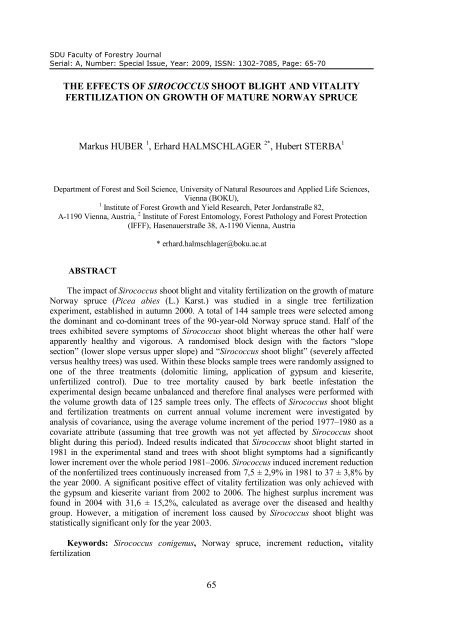sdu faculty of forestry journal special edition 2009 - Orman Fakültesi
sdu faculty of forestry journal special edition 2009 - Orman Fakültesi
sdu faculty of forestry journal special edition 2009 - Orman Fakültesi
You also want an ePaper? Increase the reach of your titles
YUMPU automatically turns print PDFs into web optimized ePapers that Google loves.
SDU Faculty <strong>of</strong> Forestry Journal<br />
Serial: A, Number: Special Issue, Year: <strong>2009</strong>, ISSN: 1302-7085, Page: 65-70<br />
THE EFFECTS OF SIROCOCCUS SHOOT BLIGHT AND VITALITY<br />
FERTILIZATION ON GROWTH OF MATURE NORWAY SPRUCE<br />
Markus HUBER 1 , Erhard HALMSCHLAGER 2* , Hubert STERBA 1<br />
Department <strong>of</strong> Forest and Soil Science, University <strong>of</strong> Natural Resources and Applied Life Sciences,<br />
Vienna (BOKU),<br />
1 Institute <strong>of</strong> Forest Growth and Yield Research, Peter Jordanstraße 82,<br />
A-1190 Vienna, Austria, 2 Institute <strong>of</strong> Forest Entomology, Forest Pathology and Forest Protection<br />
(IFFF), Hasenauerstraße 38, A-1190 Vienna, Austria<br />
ABSTRACT<br />
* erhard.halmschlager@boku.ac.at<br />
The impact <strong>of</strong> Sirococcus shoot blight and vitality fertilization on the growth <strong>of</strong> mature<br />
Norway spruce (Picea abies (L.) Karst.) was studied in a single tree fertilization<br />
experiment, established in autumn 2000. A total <strong>of</strong> 144 sample trees were selected among<br />
the dominant and co-dominant trees <strong>of</strong> the 90-year-old Norway spruce stand. Half <strong>of</strong> the<br />
trees exhibited severe symptoms <strong>of</strong> Sirococcus shoot blight whereas the other half were<br />
apparently healthy and vigorous. A randomised block design with the factors “slope<br />
section” (lower slope versus upper slope) and “Sirococcus shoot blight” (severely affected<br />
versus healthy trees) was used. Within these blocks sample trees were randomly assigned to<br />
one <strong>of</strong> the three treatments (dolomitic liming, application <strong>of</strong> gypsum and kieserite,<br />
unfertilized control). Due to tree mortality caused by bark beetle infestation the<br />
experimental design became unbalanced and therefore final analyses were performed with<br />
the volume growth data <strong>of</strong> 125 sample trees only. The effects <strong>of</strong> Sirococcus shoot blight<br />
and fertilization treatments on current annual volume increment were investigated by<br />
analysis <strong>of</strong> covariance, using the average volume increment <strong>of</strong> the period 1977–1980 as a<br />
covariate attribute (assuming that tree growth was not yet affected by Sirococcus shoot<br />
blight during this period). Indeed results indicated that Sirococcus shoot blight started in<br />
1981 in the experimental stand and trees with shoot blight symptoms had a significantly<br />
lower increment over the whole period 1981–2006. Sirococcus induced increment reduction<br />
<strong>of</strong> the nonfertilized trees continuously increased from 7,5 ± 2,9% in 1981 to 37 ± 3,8% by<br />
the year 2000. A significant positive effect <strong>of</strong> vitality fertilization was only achieved with<br />
the gypsum and kieserite variant from 2002 to 2006. The highest surplus increment was<br />
found in 2004 with 31,6 ± 15,2%, calculated as average over the diseased and healthy<br />
group. However, a mitigation <strong>of</strong> increment loss caused by Sirococcus shoot blight was<br />
statistically significant only for the year 2003.<br />
Keywords: Sirococcus conigenus, Norway spruce, increment reduction, vitality<br />
fertilization<br />
65








